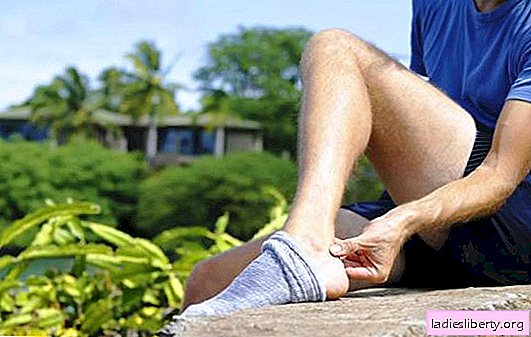
Achilles tendon inflammation is a fairly common disease, which is most often observed in athletes after serious physical exertion. Despite this, even in people who are not involved in sports, the development of this disease is possible. Consider in more detail the causes of inflammation of the Achilles tendon and ways to eliminate such an ailment.
Symptoms and signs of inflammation of the Achilles tendon
Usually, Achilles tendon inflammation is accompanied by the following symptoms:
1. The appearance of acute cutting pain, which is localized in the heel area and gives to the area under the calves. The nature of the pain is burning, growing, pulling. At the same time, the pain syndrome is sometimes so high that a person is completely unable to fully step on his leg.
2. An increase in body temperature is possible with a running course of inflammation.
3. Redness of the skin in the area of the inflamed tendon.
4. The appearance of a characteristic crunch of bones in the ankle, which manifests itself with movement of the foot.
5. The development of severe soft tissue edema in the Achilles tendon.
6. Feeling of pulsation in the leg.
7. Discomfort when stepping on the foot.
Achilles tendon inflammation: causes
As a rule, the Achilles tendon becomes inflamed for the following reasons:
1. Congenital pathologies of the development of this tendon in childhood lead to the fact that the child constantly walk on fingers alone. At the same time, even in comfortable shoes with flat soles, the baby will not be able to fully step on the leg. With age, this problem usually does not disappear anywhere, as the tendon is greatly shortened. This leads to chronic inflammation and even lameness.
2. Clubfoot or flat feet are also congenital defects in the development of the foot, which makes it difficult for a person to walk. Moreover, he can not only inflame the tendon, but also there is a constant swelling of the feet, pain when walking and rapid fatigue of the legs.
3. The constant wearing of uncomfortable shoes that are too small or rubs is extremely negatively displayed on the general condition of the foot and can easily cause inflammation of the tendon.
Wearing high-heeled shoes is even more dangerous. This is explained by the fact that when wearing shoes with heels, the Achilles tendon is gradually shortened, since he just no longer needs to stretch for walking on ordinary flat soles. Over time, the problem is delayed so much that when a woman decides to go in for sports and shoes sneakers, she is simply uncomfortable walking. This leads to inflammation.
4. Excessive physical load on the foot leads to its overstrain and the development of inflammation in the tendon. Usually this is observed in athletes during intense training.
5. Imbalance in the body.
6. High blood cholesterol.
7. Previously suffered foot injury.
Methods for treating Achilles tendon inflammation
Before starting treatment, you should diagnose the disease. For this, the patient should conduct such studies and procedures:
1. General analysis of blood and urine.
2. Ultrasound of the foot.
3. Radiography.
4. Examination and palpation of the foot at the traumatologist and surgeon.
After a diagnosis is established, a person is prescribed treatment, depending on the neglect of the disease and the observed symptoms.
Drug therapy provides for the appointment of such groups of drugs:
1. Anesthetics (analgesics) are used for severe pain.
2. Antispasmodics can be used for sharp bouts of pain.
3. Antipyretic drugs are prescribed at high temperature.
4. Anti-inflammatory drugs.
5. Drugs to improve blood circulation.
6. Vitamin complexes.
Physiotherapeutic treatment is prescribed after drug therapy. It provides for the following procedures:
1. Massage. It should be done by a specialist. The duration of the massage treatment should include at least ten sessions.
2. Mud treatment.
3. Ozokerite.
4. The use of paraffin baths.
The traditional treatment of inflammation of the Achilles tendon has the following features:
1. A patient with severe pain is recommended to observe bed rest. When the pain subsides a little, you can move around with a cane.
2. If it is impossible to step on the foot for better immobilization of the foot, it is recommended to wrap it tightly with an elastic bandage. Alternatively, a gypsum splint can be applied instead.
3. At the time of treatment, it is important to completely exclude any physical activity on a sore leg.
4. Applying cold compresses to the sore leg.
5. Wearing special fixing shoes.
Surgical treatment is prescribed to patients in the absence of the expected effect of drug treatment. Usually it is carried out with severe damage to the tendon and its rupture.
The operation itself consists in suturing the ends of a torn or damaged tendon with synthetic threads. In this case, usually the operation is done by a closed method (without an open surgical incision).
The duration of recovery after such treatment is usually from one to three months. During this period, a person should adhere to such recommendations:
1. Avoid any physical exertion on the legs.
2. Treat the area from the operation with antiseptic solutions so that the wounds heal faster. You can also apply sterile dressings and healing ointments. In this case, all the funds that are used should be discussed with the attending physician, especially with regard to the oral administration of pain medication.
3. Within a month after the operation, it is necessary to constantly wear a plaster cast dressing.
4. To improve blood circulation, the foot should often be raised above the level of the pelvis. To do this, it will be enough just to lay a high pillow under the sore leg.
5. If you experience severe pain or suppuration, it is important to immediately inform your doctor.
Achilles tendon inflammation: treatment and prevention
In order to prevent the development of inflammation of the Achilles tendon, the following medical recommendations should be adhered to:
1. Temporarily stop playing sports if they cause pain in the leg. Usually 1-2 weeks are enough for the muscles to "rest" and return to shape to resume sports activities. If during this time the pain persists, then the break should be extended. In this case, it is strictly forbidden to train with visible pain.
2. If swelling of the legs occurs, they need to be rewound with an elastic bandage to restore blood circulation. Cold compresses with ice, which are allowed to pin for no more than twenty minutes, will also help.
3. To relieve foot fatigue, massage should be done. For this, massage oils can also be used.
4. Orthopedic insoles for shoes should be used so that they remove the load from the feet. In addition, there are now special heel inserts that will reduce tendon tension and help get rid of existing inflammation.
5. Shoes with high heels can be worn, but only in special cases and then, not for the whole day.
6. Each time before strong physical exertion on the legs, it is recommended to do a special warm-up for the feet.
7. You should choose shoes with a hard back that will fix the foot well.
8. If there are first suspicions of tendon inflammation, it is important to immediately consult a doctor and not to delay your condition, otherwise otherwise, dangerous complications cannot be avoided.
In the absence of timely treatment for inflammation of the Achilles tendon, a person may develop such complications:
1. Chronic pain in the leg, due to which he simply will not be able to step on the foot. This will lead to lameness.
2. Tendency to tendon rupture. At the same time, the tendon rupture itself will bring much more pain and significantly extend the course of treatment.
3. The development of tendonitis or tendinosis - a condition in which the tendon structure is deformed. This leads to its fragility and tendency to tear.
4. Chronic swelling of the lower part of the legs, which will not only lead to circulatory disorders, but also significantly complicate the process of wearing shoes (due to swelling of the foot, narrow shoes simply cannot be worn).
5. Fever and weakness appear as a result of constant inflammation and stress in the body.











